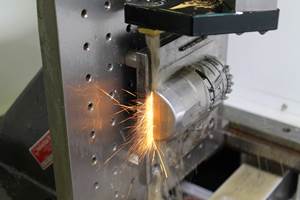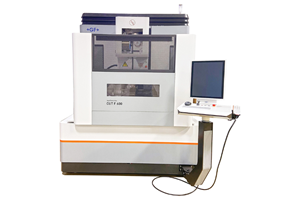Spark Control Pushes Wire EDM Boundaries
Precisely controlling and monitoring each individual spark enables this wire EDM machine to cut hardened, high-temperature alloys with high precision.
Share






While not traditionally considered a viable option for machining high-temperature alloys, wire EDM is getting a second look from shops struggling with titanium, Inconel and other such problematic but increasingly popular materials. In fact, the latest wire EDM machines can not only effectively cut these hardened, often proprietary metal blends, but can do so with unprecedented levels of speed and precision.
Fanuc’s new Robocut iE series is representative of this next generation of wire EDM technology. Available from Methods Machine Tools, these machines are said to achieve geometric accuracy to less than 0.0001 inch. They also virtually eliminate the undesirable effects of recast layers and other surface finish imperfections that once limited wire EDM’s application in high-temperature alloys, the company says.
In large part, the machine accomplishes these benefits by both controlling and monitoring the tens of thousands of tiny sparks discharged each second to remove material from the workpiece, says Steve Bond, national sales manager at Methods Machine Tools. Spark control is accomplished primarily via a new digital power supply with an embedded microprocessor. Through complex calculations, the power supply adjusts each spark’s energy, duration and other properties. The goal is to ensure effective cutting without generating enough heat to cause some of the workpiece material to re-adhere to the part surface as a recast layer. The spark properties required to achieve that end differ from alloy to alloy, so the power supply must be “tuned” according to the particular material. Mr. Bond explains that this is accomplished by reducing the power on the wire (voltage and amperage) on the final two skim cuts using Fanuc’s pulse mode 15.
A redesigned lower arm facilitates spark control by preventing stray electrical energy throughout the machine enclosure from adding heat that can contribute to recast layer formation. During finishing passes, the lower arm power feed contact moves away from the wire. Meanwhile, a specially designed diamond guide keeps the wire in place. This effectively isolates the lower head from the rest of the machine tool to keep energy out of the rest of the enclosure and concentrated where it belongs: in the wire at the point of the cut. “The less mechanical parts you’ve got up against the wire that can take power away from it, the better off you are,” Mr. Bond explains.
He emphasizes that despite these advances, EDM is a thermal process, so it will always create some recast. Nonetheless, the Robocut iE machines outclass what past wire EDMs have achieved in machining high-temperature alloys, he says. “You have your naysayers, but it’s getting attention from people who say they’ve never seen these kinds of results before off any other EDM. One could argue that you can never totally get rid of recast, and that’s true, but these machines are still producing aerospace and medical parts in titanium, Inconel, Waspalloy and other materials that are more than acceptable.”
While controlling spark properties prevents recast and other imperfections, monitoring the spark and adjusting cutting parameters accordingly improves speed, accuracy and surface finish, Mr. Bond says. For that, the iE series incorporates Ai Pulse Control, a feature that determines whether each discharge pulse has effectively contributed to material removal. Then, it adjusts the feed rate according to the number of effective discharge pulses. This keeps the energy density and the discharge gap uniform to enable smoother cutting at higher speeds, significantly reducing witness lines and other surface imperfections. “This is a form of adaptive control, but it’s the next generation,” Mr. Bond explains. “Before, we could only monitor the total voltage gap, but now we’re actually monitoring each spark. That is much more accurate and much more responsive to what is going on in the cut.”
Related Content
EDM Network Wire EDM Features Four-Axis Cutting
The EDMMax 434W fast-wire EDM includes four-axis cutting capability that enables it to cut 3D support structures or other shop-related parts.
Read MoreBelmont Small-Hole EDM Features Multitasking Capabilities
The SY-4060 provides automatic depth control, three-step control of EDM parameters and conversational G- and M-code programming.
Read MoreNew Look, New Feel, New Robots at System 3R
Are AMRs the next big trend in job shop automation? System 3R’s IMTS booth will emphasize both its specialty EDM tooling and its automation products, including an autonomous moving robot.
Read MoreGF Machining Solutions Wire EDM Features Improved Thermal Stabilization
The Cut F 600 wire EDM features machining enhancements and functions to automatically identify and adapt wire speed during the wire EDM process.
Read MoreRead Next
Machine Shop MBA
Making Chips and 91±¬ÁĎÍř are teaming up for a new podcast series called Machine Shop MBA—designed to help manufacturers measure their success against the industry’s best. Through the lens of the 91±¬ÁĎÍř benchmarking program, the series explores the KPIs that set high-performing shops apart, from machine utilization and first-pass yield to employee engagement and revenue per employee.
Read MoreAMRs Are Moving Into Manufacturing: 4 Considerations for Implementation
AMRs can provide a flexible, easy-to-use automation platform so long as manufacturers choose a suitable task and prepare their facilities.
Read More




















